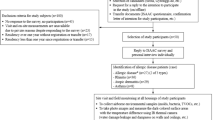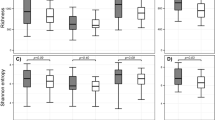Extracting DNA from the air – DNA evidence of human occupancy in indoor premises
从空气中提取DNA:室内环境中人类活动痕迹的DNA证据
Loading [MathJax]/jax/output/HTML-CSS/config.js
您的隐私,您的选择
我们使用必要的 cookies 来确保网站正常运行。我们还使用可选的 cookies 进行广告、内容个性化、使用情况分析和社交媒体。
通过接受可选 cookies,您同意处理您的个人数据——包括传输给第三方。一些第三方位于欧洲经济区之外,数据保护标准各不相同。
有关使用您个人数据的更多信息,请参阅我们的隐私政策。
管理偏好以获取更多信息并更改您的选择。
接受所有 cookies 跳至主要内容 感谢您访问 nature.com。您使用的浏览器版本对 CSS 的支持有限。为了获得最佳体验,我们建议您使用更新的浏览器(或关闭 Internet Explorer 中的兼容模式)。与此同时,为了确保持续支持,我们正在显示不带样式和 JavaScript 的网站。
搜索
按主题、关键字或作者搜索文章
显示所有期刊的搜索结果 本期刊
搜索 高级搜索
快捷链接
* [按主题浏览文章](https://www.nature.com/articles/</subjects>)
* [查找工作](https://www.nature.com/articles/</naturecareers>)
* [作者指南](https://www.nature.com/articles/</authors/index.html>)
* [编辑政策](https://www.nature.com/articles/</authors/editorial_policies/>)
浏览内容
* [ 研究文章 ](https://www.nature.com/articles/</srep/research-articles>)
* [ 新闻与评论 ](https://www.nature.com/articles/</srep/news-and-comment>)
* [ 合集 ](https://www.nature.com/articles/</srep/collections>)
* [ 主题 ](https://www.nature.com/articles/</srep/browse-subjects>)
* [在 Facebook 上关注我们 ](https://www.nature.com/articles/<https:/www.facebook.com/scientificreports>)
* [在 Twitter 上关注我们 ](https://www.nature.com/articles/<https:/twitter.com/SciReports>)
* [注册订阅提醒 ](https://www.nature.com/articles/<https:/www.nature.com/my-account/alerts/subscribe-journal?list-id=288>)
* [ RSS feed ](https://www.nature.com/articles/<https:/www.nature.com/srep.rss>)
关于本期刊
* [ 关于 Scientific Reports ](https://www.nature.com/articles/</srep/about>)
* [ 联系方式 ](https://www.nature.com/articles/</srep/contact>)
* [ 期刊政策 ](https://www.nature.com/articles/</srep/journal-policies>)
* [ 审稿人指南 ](https://www.nature.com/articles/</srep/guide-to-referees>)
* [ 征稿启事 ](https://www.nature.com/articles/</srep/calls-for-papers>)
* [ 编辑精选 ](https://www.nature.com/articles/</srep/editorschoice>)
* [ 期刊亮点 ](https://www.nature.com/articles/</srep/highlights>)
* [ 开放获取费用和资助 ](https://www.nature.com/articles/</srep/open-access>)
与我们一起出版
* [ 面向作者 ](https://www.nature.com/articles/</srep/author-instructions>)
* [ 语言编辑服务 ](https://www.nature.com/articles/<https:/authorservices.springernature.com/go/sn/?utm_source=For+Authors&utm_medium=Website_Nature&utm_campaign=Platform+Experimentation+2022&utm_id=PE2022>)
* [提交稿件 ](https://www.nature.com/articles/<https:/author-welcome.nature.com/41598>)
- nature
- scientific reports
- articles
- article
看不见的证人:空气和灰尘作为室内环境中人类活动痕迹的DNA证据 下载 PDF 下载 PDF
- Article
- Open access
- Published: 04 November 2023
看不见的证人:空气和灰尘作为室内环境中人类活动痕迹的DNA证据
显示作者 Scientific Reports volume 13, Article number: 19059 (2023) Cite this article
- 8087 Accesses
- 9 Citations
- 11 Altmetric
- Metrics details
摘要
人类不断地将脱氧核糖核酸 (DNA) 释放到周围环境中。这些 DNA 可能悬浮在空气中,也可能作为室内灰尘沉降到物体表面。在本研究中,我们探索了利用从空气和灰尘中回收的人类 DNA 来调查无法获得可见痕迹的犯罪行为的潜力——例如,最近腾空的毒品工厂,其中存在多名工人。样本采集自三个室内场所(办公室、会议室和实验室),这些场所的占用类型和清洁制度各不相同。将产生的 DNA 图谱与场所 55 名居住者的参考图谱进行比较。我们的研究结果表明,室内灰尘样本是 DNA 的丰富来源,并提供了特定收集地点内居住者的历史记录。在超净法医实验室的空气和灰尘样本中也观察到可检测水平的 DNA,这可能会污染案件样本。我们提供了一个贝叶斯统计模型来估计检测一个地点所有居民所需的最少灰尘样本数量。本研究的结果表明,空气和灰尘可能成为一种新型的 DNA 证据来源,用于识别犯罪现场的当前和过去居住者。
其他人正在查看的类似内容

韩国水损房屋中室内霉菌和潮湿暴露与过敏性疾病的关联
Article Open access 02 January 2024

养狗与室内灰尘微生物群之间的关联
Article Open access 05 March 2021

SARS-CoV-2 的空气、表面和废水监测;对建筑环境中 COVID-19 检测的多模式评估
Article Open access 01 March 2025
引言
一个成年人每小时每平方厘米脱落约 1000 个皮肤细胞,导致每天从身体释放出数十亿个细胞[1](https://www.nature.com/articles/</articles/s41598-023-46151-7#ref-CR1> "Roberts, D. & Marks, R. The determination of regional and age variations in the rate of desquamation: A comparison of four techniques. J. Invest. Dermatol. 74, 13–16. https://doi.org/10.1111/1523-1747.ep12514568
(1980)."),[2](https://www.nature.com/articles/</articles/s41598-023-46151-7#ref-CR2> "Milstone, L. M. Epidermal desquamation. J. Dermatol. Sci. 36, 131–140.
https://doi.org/10.1016/j.jdermsci.2004.05.004
(2004)."). 这种情况是通过表皮脱屑发生的,表皮脱屑是一个连续的过程,构成了角质形成细胞分化程序的最后一步。脱屑会导致死皮细胞(称为角质细胞)自发脱落[2](https://www.nature.com/articles/<#ref-CR2> "Milstone, L. M. Epidermal desquamation. J. Dermatol. Sci. 36, 131–140.
https://doi.org/10.1016/j.jdermsci.2004.05.004
(2004)."),[3](https://www.nature.com/articles/<#ref-CR3> "Candi, E., Schmidt, R. & Melino, G. The cornified envelope: A model of cell death in the skin. Nat. Rev. Mol. Cell Biol. 6, 328–340.
https://doi.org/10.1038/nrm1619
(2005)."),[4](https://www.nature.com/articles/</articles/s41598-023-46151-7#ref-CR4> "Sun, T. T. & Green, H. Differentiation of the epidermal keratinocyte in cell culture: Formation of the cornified envelope. Cell 9, 511–521.
https://doi.org/10.1016/0092-8674(76)90033-7
(1976)."). 这些皮肤颗粒的平均尺寸小于典型服装织物的孔隙,从而使它们可以通过并雾化[5](https://www.nature.com/articles/</articles/s41598-023-46151-7#ref-CR5> "Lidwell, O. M., Mackintosh, C. A. & Towers, A. G. The evaluation of fabrics in relation to their use as protective garments in nursing and surgery. II. Dispersal of skin organisms in a test chamber. J. Hyg. (Lond.) 81, 453–469.
https://doi.org/10.1017/s002217240002533x
(1978)."),[6](https://www.nature.com/articles/</articles/s41598-023-46151-7#ref-CR6> "Mackintosh, C. A., Lidwell, O. M., Towers, A. G. & Marples, R. R. The dimensions of skin fragments dispersed into the air during activity. J. Hyg. (Lond.) 81, 471–479.
https://doi.org/10.1017/s0022172400025341
(1978)."). 不同数量级的 DNA 可能保留在角质细胞内;足以产生可检测的图谱[7](https://www.nature.com/articles/<#ref-CR7> "Burrill, J., Daniel, B. & Frascione, N. Illuminating touch deposits through cellular characterization of hand rinses and body fluids with nucleic acid fluorescence. Forensic Sci. Int. Genet. 46, 102269.
https://doi.org/10.1016/j.fsigen.2020.102269
(2020)."),[8](https://www.nature.com/articles/<#ref-CR8> "Kanokwongnuwut, P., Kirkbride, K. P. & Linacre, A. Detection of latent DNA. Forensic Sci. Int. Genet. 37, 95–101.
https://doi.org/10.1016/j.fsigen.2018.08.004
(2018)."),[9](https://www.nature.com/articles/<#ref-CR9> "Burrill, J., Rammenou, E., Alawar, F., Daniel, B. & Frascione, N. Corneocyte lysis and fragmented DNA considerations for the cellular component of forensic touch DNA. Forensic Sci. Int. Genet. 51, 102428.
https://doi.org/10.1016/j.fsigen.2020.102428
(2021)."),[10](https://www.nature.com/articles/</articles/s41598-023-46151-7#ref-CR10> "Hammer, U., Bulnheim, U., Karstädt, G., Meissner, D. & Wegener, R. Zur DNA-Typisierung übertragener Hautzellen nach körperlicher Gewalt. Rechtsmedizin 7, 180–183.
https://doi.org/10.1007/s001940050010
(1997)."). DNA 不仅可以通过皮肤细胞释放到空气中,还可以通过其他形式释放。头皮屑构成人类脱落的生物气溶胶物质的一部分,单个颗粒包含 0.8 至 16.6 ng 的 DNA[11](https://www.nature.com/articles/</articles/s41598-023-46151-7#ref-CR11> "Herber, B. & Herold, K. DNA typing of human dandruff. J. Forensic Sci. 43, 648–656 (1998)."). 个人说话、咳嗽或打喷嚏也可以将可检测量的 DNA 转移到周围环境中[12](https://www.nature.com/articles/<#ref-CR12> "Finnebraaten, M., Granér, T. & Hoff-Olsen, P. May a speaking individual contaminate the routine DNA laboratory?. Forensic Sci. Int. Genet. Suppl. Ser. 1, 421–422.
https://doi.org/10.1016/j.fsigss.2007.10.030
(2008)."),[13](https://www.nature.com/articles/<#ref-CR13> "Port, N. J., Bowyer, V. L., Graham, E. A., Batuwangala, M. S. & Rutty, G. N. How long does it take a static speaking individual to contaminate the immediate environment?. Forensic Sci. Med. Pathol. 2, 157–163.
https://doi.org/10.1007/s12024-006-0004-z
(2006)."),[14](https://www.nature.com/articles/</articles/s41598-023-46151-7#ref-CR14> "Rutty, G. N., Hopwood, A. & Tucker, V. The effectiveness of protective clothing in the reduction of potential DNA contamination of the scene of crime. Int. J. Legal Med. 117, 170–174.
https://doi.org/10.1007/s00414-002-0348-1
(2003)."). 在没有直接接触的情况下,通过搅动干燥的生物材料(包括接触过的表面上的 DNA)以及衣服等个人物品,也证明了间接 DNA 转移的可能性[15](https://www.nature.com/articles/</articles/s41598-023-46151-7#ref-CR15> "Thornbury, D., Goray, M. & van Oorschot, R. A. H. Indirect DNA transfer without contact from dried biological materials on various surfaces. Forensic Sci. Int. Genet. 51, 102457.
https://doi.org/10.1016/j.fsigen.2020.102457
(2021)."),[16](https://www.nature.com/articles/</articles/s41598-023-46151-7#ref-CR16> "Thornbury, D., Goray, M. & van Oorschot, R. A. H. Transfer of DNA without contact from used clothing, pillowcases and towels by shaking agitation. Sci. Justice 61, 797–805.
https://doi.org/10.1016/j.scijus.2021.10.005
(2021)."). 个人可以将 DNA 沉积在他们所占据区域内未接触的表面上;检测到 DNA 的概率随着他们存在的时间而增加[17](https://www.nature.com/articles/</articles/s41598-023-46151-7#ref-CR17> "Puliatti, L., Handt, O. & Taylor, D. The level of DNA an individual transfers to untouched items in their immediate surroundings. Forensic Sci. Int. Genet. 54, 102561.
https://doi.org/10.1016/j.fsigen.2021.102561
(2021)."). 此外,在个人将其 DNA 脱落到周围环境的倾向中观察到显着差异,而无需直接接触表面;可以将“环境脱落者状态”[17](https://www.nature.com/articles/</articles/s41598-023-46151-7#ref-CR17> "Puliatti, L., Handt, O. & Taylor, D. The level of DNA an individual transfers to untouched items in their immediate surroundings. Forensic Sci. Int. Genet. 54, 102561.
https://doi.org/10.1016/j.fsigen.2021.102561
(2021).") 分配给个人,以量化这种变异性。漂浮在空气中的皮肤细胞和 DNA 片段构成了室内灰尘的很大一部分[18](https://www.nature.com/articles/</articles/s41598-023-46151-7#ref-CR18> "Locard, E. The analysis of dust traces. Part I. Am. J. Police Sci. 1, 276–298.
https://doi.org/10.2307/1147154
(1930)."),[19](https://www.nature.com/articles/</articles/s41598-023-46151-7#ref-CR19> "Toothman, M. H. et al. Characterization of human DNA in environmental samples. Forensic Sci. Int. 178, 7–15.
https://doi.org/10.1016/j.forsciint.2008.01.016
(2008)."). Toothman 等人先前证明[19](https://www.nature.com/articles/</articles/s41598-023-46151-7#ref-CR19> "Toothman, M. H. et al. Characterization of human DNA in environmental samples. Forensic Sci. Int. 178, 7–15.
https://doi.org/10.1016/j.forsciint.2008.01.016
(2008).") 室内灰尘中存在足够数量和质量的人类 DNA,可以在 STR 分析中产生等位基因调用。然而,本文中描述的工作是第一个探索利用空气和灰尘来调查严重犯罪的潜在用途的研究,同时描述了局限性和潜在的陷阱。
在警方调查中,有许多案件需要识别犯罪现场的个人[20](https://www.nature.com/articles/</articles/s41598-023-46151-7#ref-CR20> "Amankwaa, A. O. & McCartney, C. The effectiveness of the current use of forensic DNA in criminal investigations in England and Wales. Wiley Interdiscip. Rev. Forensic Sci. 3, e1414. https://doi.org/10.1002/wfs2.1414
(2021)."). 一些例子是盗窃、凶杀、家庭暴力案件以及非法组织成员的身份识别。通常,最困难的案件涉及有组织犯罪和恐怖主义,参与者可能具有法医意识,因此传统的 DNA 和指纹检测可能难以实现。当 (a) 没有体液可以识别,(b) 表面(如桌子、门把手、灯开关)可能已被清洁,或 (c) 罪犯可能戴着手套时,就会发生这种情况,从而最大限度地减少他们与表面的直接皮肤接触。
此外,犯罪分子通常会使用“安全屋”,这些“安全屋”可能会随着时间的推移而改变,以逃避侦查。这些“安全屋”充当各种非法活动的临时场所,从生产非法毒品和爆炸物到容纳邪教、诈骗集团和无牌诊所等非法组织,通常采用巧妙的伪装[21](https://www.nature.com/articles/</articles/s41598-023-46151-7#ref-CR21> "Secretary of State for the Home Department (2013). Serious and Organised Crime Strategy.UK: The Stationery Office. https://www.gov.uk/government/publications/serious-organised-crime-strategy
."). 这些活动,无论其性质如何,都可能导致警方根据情报报告进行突袭。在此类行动中,虽然可能会逮捕一些当前的居住者,但至关重要的是不仅要收集当前在场人员的证据,还要收集过去可能与这些地点相关联的个人的证据。为了实现这一目标,从灰尘中分离出的 DNA 提供了一个历史记录,可能有助于识别几个月到几年的长期时间范围内居住者。相反,从空气样本中提取的 DNA 可以提供更近期的记录:在罪犯在密闭区域内停留的时间较短,不足以让皮肤细胞和 DNA 在灰尘中积累的情况下,收集空气样本可能很有用。例如,在汽车盗窃案中,空气可能是一种有价值的信息来源,有法医意识的罪犯可能会注意戴手套,这减少了从方向盘等表面检测到 DNA 的可能性。
虽然犯罪调查是一个强大的动机,但重要的是要考虑在实验室环境中收集和分析空气和灰尘样本的实际意义。DNA 技术的高灵敏度使得可以从极低水平的生物材料(仅几个细胞)获得结果[22](https://www.nature.com/articles/</articles/s41598-023-46151-7#ref-CR22> "Watkins, D. R. L., Myers, D., Xavier, H. E. & Marciano, M. A. Revisiting single cell analysis in forensic science. Sci. Rep. 11, 7054. https://doi.org/10.1038/s41598-021-86271-6
(2021)."),[23](https://www.nature.com/articles/</articles/s41598-023-46151-7#ref-CR23> "van Oorschot, R. A., Ballantyne, K. N. & Mitchell, R. J. Forensic trace DNA: A review. Investig. Genet. 1, 14.
https://doi.org/10.1186/2041-2223-1-14
(2010)."). 因此,环境背景 DNA(定义为来自未知个体[24](https://www.nature.com/articles/</articles/s41598-023-46151-7#ref-CR24> "van Oorschot, R. A. H., Szkuta, B., Meakin, G. E., Kokshoorn, B. & Goray, M. DNA transfer in forensic science: A review. Forensic Sci. Int. Genet. 38, 140–166.
https://doi.org/10.1016/j.fsigen.2018.10.014
(2019)."))被检测到的可能性增加[24](https://www.nature.com/articles/<#ref-CR24> "van Oorschot, R. A. H., Szkuta, B., Meakin, G. E., Kokshoorn, B. & Goray, M. DNA transfer in forensic science: A review. Forensic Sci. Int. Genet. 38, 140–166.
https://doi.org/10.1016/j.fsigen.2018.10.014
(2019)."),[25](https://www.nature.com/articles/<#ref-CR25> "Gill, P. DNA evidence and miscarriages of justice. Forensic Sci. Int. 294, e1–e3.
https://doi.org/10.1016/j.forsciint.2018.12.003
(2019)."),[26](https://www.nature.com/articles/<#ref-CR26> "Fonneløp, A. E., Johannessen, H., Egeland, T. & Gill, P. Contamination during criminal investigation: Detecting police contamination and secondary DNA transfer from evidence bags. Forensic Sci. Int. Genet. 23, 121–129.
https://doi.org/10.1016/j.fsigen.2016.04.003
(2016)."),[27](https://www.nature.com/articles/<#ref-CR27> "Reither, J. B. et al. Investigation into the prevalence of background DNA on flooring within houses and its transfer to a contacting surface. Forensic Sci. Int. 318, 110563.
https://doi.org/10.1016/j.forsciint.2020.110563
(2021)."),[28](https://www.nature.com/articles/<#ref-CR28> "Proff, C., Schmitt, C., Schneider, P. M., Foerster, G. & Rothschild, M. A. Experiments on the DNA contamination risk via latent fingerprint brushes. Int. Congress Ser. 1288, 601–603.
https://doi.org/10.1016/j.ics.2005.10.053
(2006)."),[29](https://www.nature.com/articles/<#ref-CR29> "van den Berge, M., Ozcanhan, G., Zijlstra, S., Lindenbergh, A. & Sijen, T. Prevalence of human cell material: DNA and RNA profiling of public and private objects and after activity scenarios. Forensic Sci. Int. Genet. 21, 81–89.
https://doi.org/10.1016/j.fsigen.2015.12.012
(2016)."),[30](https://www.nature.com/articles/</articles/s41598-023-46151-7#ref-CR30> "Vandewoestyne, M. et al. Sources of DNA contamination and decontamination procedures in the forensic laboratory. Int. J. Forensic Pract. Res.
https://doi.org/10.4172/2157-7145.S2-001
(2011)."). 在分析案件的实验室中,气溶胶 DNA 可能会污染证据。两项不同的研究[30](https://www.nature.com/articles/</articles/s41598-023-46151-7#ref-CR30> "Vandewoestyne, M. et al. Sources of DNA contamination and decontamination procedures in the forensic laboratory. Int. J. Forensic Pract. Res.
https://doi.org/10.4172/2157-7145.S2-001
(2011)."),[31](https://www.nature.com/articles/</articles/s41598-023-46151-7#ref-CR31> "Witt, N. et al. An assessment of air as a source of DNA contamination encountered when performing PCR. J. Biomol. Tech. 20, 236–240 (2009).")
